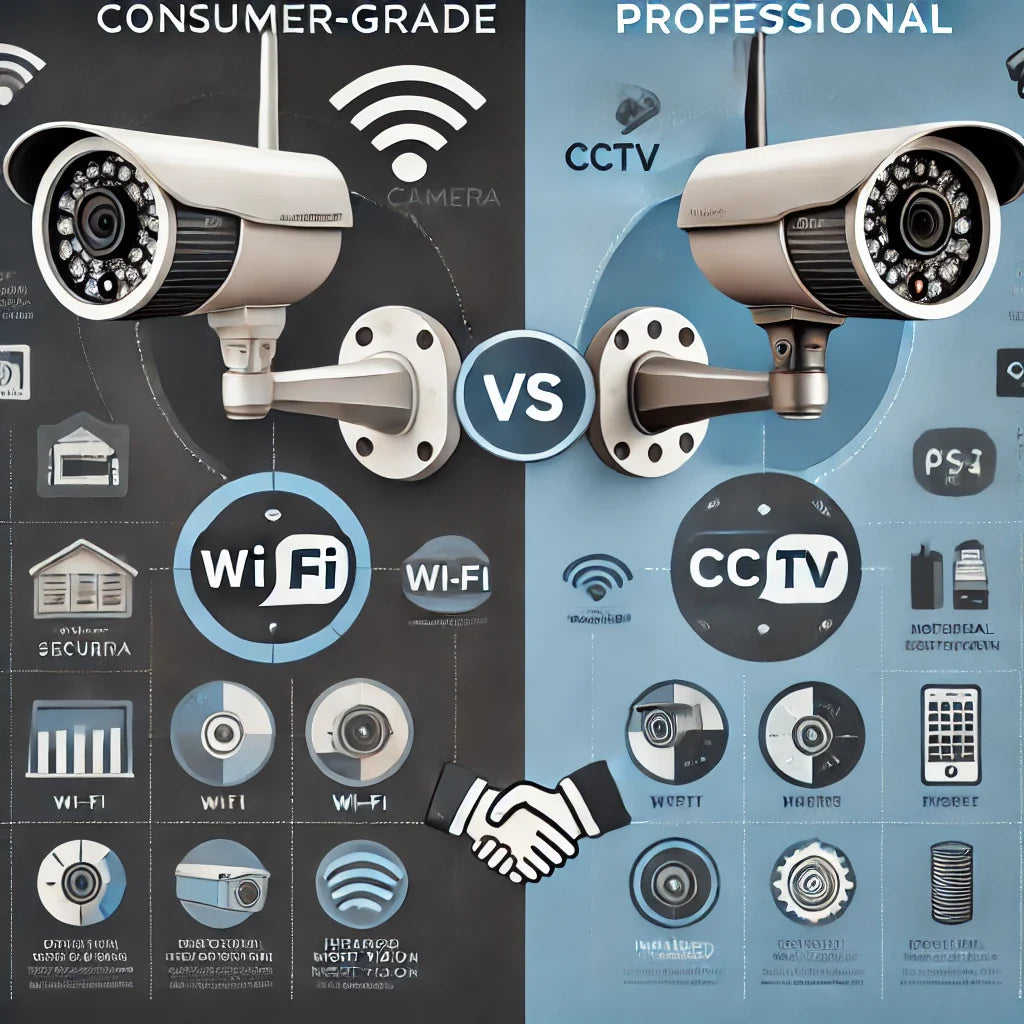
Difference Between Consumer-Grade and Professional CCTV Systems
Share
Security cameras play a vital role in safeguarding homes, businesses, and public spaces. However, not all CCTV systems are created equal. There are two primary categories of security camera systems: consumer-grade and professional-grade. While both serve the purpose of surveillance and security, they differ significantly in terms of quality, features, durability, and overall performance. Understanding these differences is crucial for choosing the right system based on security needs and budget. This article explores the key differences between consumer-grade and professional CCTV systems to help you make an informed decision.
Build Quality and Durability
Consumer-Grade CCTV Systems
Consumer-grade security cameras are designed for residential use and small businesses. These cameras are typically made from plastic or lightweight materials, which makes them affordable but less durable. They are intended for indoor or light outdoor use and may not withstand extreme weather conditions.
Professional CCTV Systems
Professional-grade security cameras are built for durability and long-term use. They are constructed using high-quality materials such as metal casings, weather-resistant coatings, and reinforced lenses. These cameras are designed to withstand harsh environmental conditions, including extreme temperatures, heavy rain, and vandalism.
Image and Video Quality
Consumer-Grade CCTV Systems
Consumer security cameras usually offer resolutions ranging from 720p to 1080p. While this resolution is sufficient for general monitoring, it may lack the clarity needed for facial recognition or license plate identification, especially at a distance.
Professional CCTV Systems
Professional systems often feature high-definition (HD) and ultra-high-definition (UHD) resolutions, such as 4K or even higher. These cameras provide superior image quality, making it easier to identify faces, license plates, and other crucial details. Additionally, professional cameras often have better low-light and infrared (IR) night vision capabilities, ensuring clear footage even in dark environments.
Storage and Data Management
Consumer-Grade CCTV Systems
Consumer-grade cameras generally rely on local storage (such as SD cards) or cloud-based storage with limited capacity. Free cloud storage options may only keep recordings for a few days, requiring users to pay for additional storage plans.
Professional CCTV Systems
Professional systems come with robust data management solutions, including network video recorders (NVRs) and digital video recorders (DVRs) with large storage capacities. Many also support redundant storage options, such as RAID configurations, ensuring data is not lost in case of a drive failure. Additionally, professional-grade CCTV systems often integrate with enterprise-level cloud storage for secure long-term data retention.
Connectivity and Integration
Consumer-Grade CCTV Systems
Consumer cameras are typically Wi-Fi-based, making them easy to install and manage. However, wireless connectivity can be unreliable, especially in areas with network congestion or interference. Most consumer-grade cameras work with mobile apps, allowing remote monitoring but with limited integration options.
Professional CCTV Systems
Professional systems use wired connections such as Power over Ethernet (PoE) to ensure stable and secure data transmission. These cameras integrate seamlessly with other security infrastructure, such as access control systems, alarm systems, and AI-powered analytics platforms. They offer more flexibility for large-scale security operations, making them ideal for businesses and government institutions.
Security and Encryption
Consumer-Grade CCTV Systems
Consumer cameras often have basic encryption protocols, making them more vulnerable to hacking and cyber threats. Many rely on cloud services for remote access, which can pose privacy risks if not properly secured.
Professional CCTV Systems
Professional-grade CCTV systems come with advanced security features, including end-to-end encryption, multi-factor authentication, and dedicated cybersecurity protocols. They are designed to meet stringent security standards, reducing the risk of unauthorized access or data breaches.
Scalability and Customization
Consumer-Grade CCTV Systems
Consumer cameras are designed for simple setups, usually supporting a few cameras per system. They are ideal for homeowners who need basic surveillance but may not offer the flexibility to expand as security needs grow.
Professional CCTV Systems
Professional security systems are highly scalable and customizable. Businesses, airports, industrial sites, and city surveillance networks rely on these systems because they can support hundreds or even thousands of cameras. Advanced features like facial recognition, AI analytics, and automated alerts make them suitable for large-scale operations.
Cost Considerations
Consumer-Grade CCTV Systems
Consumer-grade cameras are budget-friendly, with prices ranging from $50 to $300 per camera. While they are cost-effective for small-scale use, they may not provide long-term reliability or advanced features.
Professional CCTV Systems
Professional systems require a higher upfront investment, with prices ranging from $500 to several thousand dollars per camera, depending on specifications. However, the long-term benefits, including superior reliability, enhanced security features, and scalability, justify the cost for businesses and high-security applications.
While both consumer-grade and professional CCTV systems serve the purpose of security and surveillance, they cater to different needs and environments. Consumer-grade cameras are best suited for homeowners and small businesses looking for affordable and easy-to-install solutions. In contrast, professional CCTV systems provide high-performance, durable, and scalable security solutions for commercial and industrial applications.
When choosing between the two, consider factors such as image quality, durability, storage capacity, integration options, and cybersecurity measures. Investing in the right system ensures reliable security and peace of mind, whether for personal use or large-scale operations.
